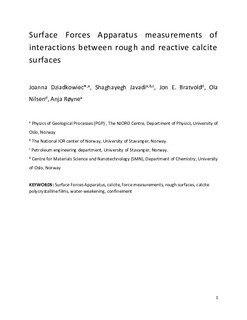| dc.contributor.author | Javadi, Shaghayegh | |
| dc.contributor.author | Bratvold, Jon E. | |
| dc.contributor.author | Nilsen, Ola | |
| dc.contributor.author | Røyne, Anja | |
| dc.contributor.author | Dziadkowie, Joanna | |
| dc.date.accessioned | 2019-02-27T14:27:40Z | |
| dc.date.available | 2019-02-27T14:27:40Z | |
| dc.date.created | 2018-06-29T17:59:51Z | |
| dc.date.issued | 2018-05 | |
| dc.identifier.citation | Dziadkowiec, J., Shavadi, S., Bratvold, J.E., et al. (2018) Surface Forces Apparatus Measurements of Interactions between Rough and Reactive Calcite Surfaces. Langmuir, 34(25), pp. 7248-7263. | nb_NO |
| dc.identifier.issn | 0743-7463 | |
| dc.identifier.uri | http://hdl.handle.net/11250/2587869 | |
| dc.description | This document is the Accepted Manuscript version of a Published Work that appeared in final form in Langmuir, copyright © American Chemical Society after peer review and technical editing by the publisher. To access the final edited and published work see https://pubs.acs.org/doi/abs/10.1021/acs.langmuir.8b00797. | nb_NO |
| dc.description.abstract | Nm-range forces acting between calcite surfaces in water affect macroscopic properties of carbonate rocks and calcite-based granular materials, and are significantly influenced by calcite surface recrystallization. We suggest that the repulsive mechanical effects related to nm-scale surface recrystallization of calcite in water could be partially responsible for the observed decrease of cohesion in calcitic rocks saturated with water. Using the Surface Forces Apparatus (SFA), we simultaneously followed the calcite reactivity and measured the forces in water in two surface configurations: between two rough calcite surfaces (CC), or between rough calcite and a smooth mica surface (CM). We used nm-scale rough, polycrystalline calcite films prepared by Atomic Layer Deposition (ALD). We measured only repulsive forces in CC in CaCO3-saturated water, which was related to roughness and possibly to repulsive hydration effects. Adhesive or repulsive forces were measured in CM in CaCO3-saturated water depending on calcite roughness, and the adhesion was likely enhanced by electrostatic effects. The pull-off adhesive force in CM became stronger with time and this increase was correlated with a decrease of roughness at contacts, which parameter could be estimated from the measured force-distance curves. That suggested a progressive increase of real contact areas between the surfaces, caused by gradual pressure-driven deformation of calcite surface asperities during repeated loading-unloading cycles. Reactivity of calcite was affected by mass transport across nm to µm-thick gaps between the surfaces. Major roughening was observed only for the smoothest calcite films, where gaps between two opposing surfaces were nm-thick over µm-sized areas, and led to force of crystallization that could overcome confining pressures of the order of MPa. Any substantial roughening of calcite caused a significant increase of the repulsive mechanical force contribution. | nb_NO |
| dc.language.iso | eng | nb_NO |
| dc.publisher | American Chemical Society | nb_NO |
| dc.subject | surface forces apparatus | nb_NO |
| dc.subject | calcite | nb_NO |
| dc.subject | force measurements | nb_NO |
| dc.subject | rough surfaces | nb_NO |
| dc.subject | calcite polycrystalline films | nb_NO |
| dc.subject | water-weakening | nb_NO |
| dc.subject | confinement | nb_NO |
| dc.title | Surface Forces Apparatus Measurements of Interactions between Rough and Reactive Calcite Surfaces | nb_NO |
| dc.type | Journal article | nb_NO |
| dc.type | Peer reviewed | nb_NO |
| dc.description.version | acceptedVersion | nb_NO |
| dc.rights.holder | Copyright © 2018 American Chemical Society | nb_NO |
| dc.subject.nsi | VDP::Technology: 500::Rock and petroleum disciplines: 510 | nb_NO |
| dc.source.pagenumber | 7248-7263 | nb_NO |
| dc.source.volume | 34 | nb_NO |
| dc.source.journal | Langmuir | nb_NO |
| dc.source.issue | 25 | nb_NO |
| dc.identifier.doi | 10.1021/acs.langmuir.8b00797 | |
| dc.identifier.cristin | 1594907 | |
| dc.relation.project | Norges forskningsråd: 230303 | nb_NO |
| cristin.unitcode | 217,8,6,0 | |
| cristin.unitname | Institutt for energi- og petroleumsteknologi | |
| cristin.ispublished | true | |
| cristin.fulltext | postprint | |
| cristin.qualitycode | 2 | |
